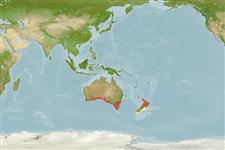Teleostei (teleosts) >
Gadiformes (Cods) >
Moridae (Morid cods)
Etymology: Pseudophycis: Greek, pseudes = false + Greek, phykon = seaweed; because of the habit of living among them (Ref. 45335).
More on author: Günther.
Environment: milieu / climate zone / depth range / distribution range
Ecology
Marine; brackish; demersal; depth range 0 - 300 m. Subtropical; 31°S - 48°S, 112°E - 180°E (Ref. 1371)
Southwest Pacific: Around New Zealand and Australia, from Sydney to Perth, although apparently rare in the west.
Size / Weight / Age
Maturity: Lm ? range ? - ? cm
Max length : 63.0 cm TL male/unsexed; (Ref. 1371)
Dorsal spines (total): 0; Anal spines: 0. Nostrils immediately anterior to eye. Pyloric caeca 16 to 20. Color is reddish pink to pale brown dorsally, becoming lighter ventrally; dorsal, anal, and caudal fins dark-edged.
Found on hard bottom, over exposed rocky reefs (Ref. 9563). Feeds mainly on benthic crustaceans (Ref. 2156). Minimum depth reported taken from Ref. 57178.
Life cycle and mating behavior
Maturity | Reproduction | Spawning | Eggs | Fecundity | Larvae
Cohen, D.M., T. Inada, T. Iwamoto and N. Scialabba, 1990. FAO species catalogue. Vol. 10. Gadiform fishes of the world (Order Gadiformes). An annotated and illustrated catalogue of cods, hakes, grenadiers and other gadiform fishes known to date. FAO Fish. Synop. 125(10). Rome: FAO. 442 p. (Ref. 1371)
IUCN Red List Status (Ref. 130435: Version 2024-2)
Threat to humans
Harmless
Human uses
Fisheries: minor commercial
Tools
Special reports
Download XML
Internet sources
Estimates based on models
Preferred temperature (Ref.
123201): 13.7 - 18.1, mean 15.5 °C (based on 189 cells).
Phylogenetic diversity index (Ref.
82804): PD
50 = 0.6250 [Uniqueness, from 0.5 = low to 2.0 = high].
Bayesian length-weight: a=0.00389 (0.00192 - 0.00787), b=3.11 (2.93 - 3.29), in cm total length, based on LWR estimates for this (Sub)family-body shape (Ref.
93245).
Trophic level (Ref.
69278): 3.5 ±0.50 se; based on food items.
Resilience (Ref.
120179): Very Low, minimum population doubling time more than 14 years (Preliminary K or Fecundity.).
Fishing Vulnerability (Ref.
59153): Moderate to high vulnerability (45 of 100).
Nutrients (Ref.
124155): Calcium = 54.6 [29.3, 115.2] mg/100g; Iron = 0.84 [0.48, 1.47] mg/100g; Protein = 18.6 [16.6, 20.8] %; Omega3 = 0.222 [0.110, 0.412] g/100g; Selenium = 39.2 [19.1, 74.1] μg/100g; VitaminA = 11.2 [3.8, 31.5] μg/100g; Zinc = 0.877 [0.619, 1.285] mg/100g (wet weight);
